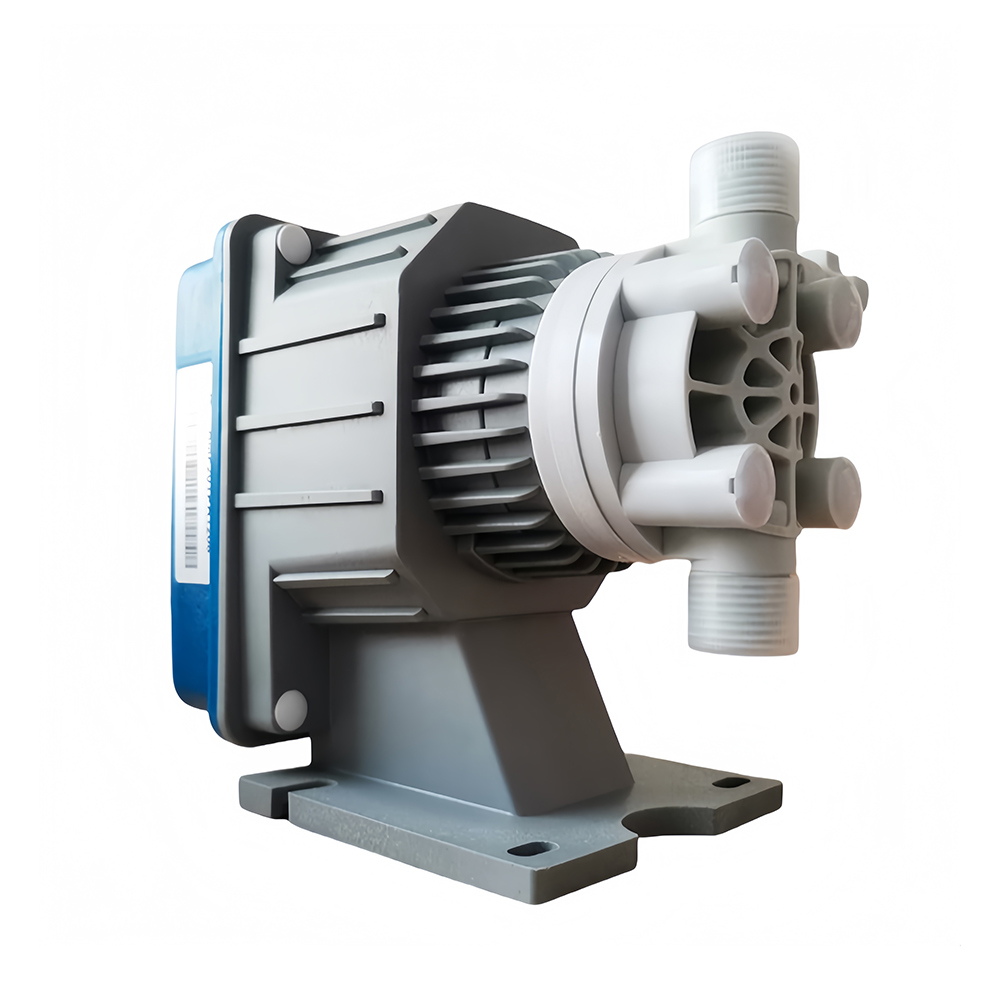How Do Electromagnetic Dosing Pumps Work?
Electromagnetic dosing pumps are established, reliable engines for precise metering of fluids across diverse industrial processes. Their configuration blends simplicity with clever engineering—leveraging electromagnetic forces within a diaphragm structure. This article offers an in-depth, technical view of operating principles, key performance traits, liquid compatibility, and the continuing centrality of electromagnetic dosing in contemporary fluid handling.
Introduction to Electromagnetic Dosing Pumps
Basically, the pump is a positive displacement unit that releases an absolutely defined volume with every charge. In place of gear trains or cam followers as in conventional motor types, the control is executed by a stationary and a moving electromagnetic coil. This configuration entails very small inertia—light, nimble, and easily commanded in automatic reagent injections.
Industries characterized by stringent dosing demands, including water and wastewater treatment, chemical processing, food and beverage, pharmaceuticals, and power generation, especially prize electromagnetic metering. In every case, the success of technically critical tasks—yield, purity, safety, and compliance audits—depends squarely on liquid volume predictability.
Working Principle of Electromagnetic Dosing Pumps
Asolenoid-powered diaphragm actuator governs each pump’s action. Embedded in each unit is an energized copper coil that builds a magnetic field; in response, a magnetic plunger shifts. The plunger is fixed to a thin, robust diaphragm that Flexes, drawing in fluid before expelling it.
1. Suction Stroke
When the solenoid is de-energized, a spring pushes the plunger back.
The diaphragm retracts, reducing pressure in the pump chamber.
This pressure drop causes the inlet check valve to open, allowing fluid to flow into the chamber.
2. Discharge Stroke
When the solenoid coil is energized, the plunger is pulled forward.
The diaphragm moves forward, compressing the fluid inside the chamber.
The outlet check valve opens, and the fluid is discharged into the process line.
This swift diaphragm cycle repeats dozens of times each second, delivering traceable volumes without dribble or delay. The pump’s shot is sized either by limiting the diaphragm’s maximal excursion, via an accessible mechanical stop, or by modifying the speed of the plunger, an option customarily decided by a low-cost onboard computer.
Key Features of Electromagnetic Dosing Pumps
Electromagnetic dosing pumps offer several distinguishing features that make them preferable in critical dosing applications:
High Accuracy : With dosing tolerances as low as ±1–2%, they are suitable for processes requiring stringent control.
Pulse-Free Flow (with accessories) : Though naturally pulsating, dampeners or multi-head designs can reduce pulsation for sensitive processes.
Compact and Lightweight : The absence of gears, motors, or complex drive assemblies makes them easy to install and maintain.
Energy Efficiency : Solenoids consume power only during actuation, minimizing energy demand.
Chemical Resistance : Pump heads and diaphragms are made from materials such as PTFE, PVDF, or stainless steel , ensuring compatibility with corrosive and aggressive fluids.

Applications of Electromagnetic Dosing Pumps
Electromagnetic dosing pumps are versatile and can handle a broad range of fluids and environments. Below are some key application areas:
1. Water and Wastewater Treatment
Used for chlorine, sodium hypochlorite, flocculants, and pH control agents. Precision dosing ensures compliance with water quality regulations and protection of downstream equipment.
2. Chemical Manufacturing and Processing
Essential for metering acids, alkalis, solvents, and additives. Their corrosion-resistant construction allows safe handling of hazardous fluids.
3. Food and Beverage Industry
For adding preservatives, flavorings, or sanitizing agents with strict hygiene requirements. Diaphragm-based pumping ensures no contamination risk.
4. Pharmaceutical and Biotechnology
In dosing active ingredients, enzymes, or sterile fluids, accuracy and repeatability are paramount. Electromagnetic dosing pumps provide both.
5. Power Plants
Used in boiler feedwater treatment to inject anti-scaling and oxygen-scavenging chemicals, protecting turbines and heat exchangers.
Advantages of Electromagnetic Dosing Pumps
Compared with other pump types, electromagnetic dosing pumps offer unique advantages:
Simple Mechanical Design : Fewer moving parts mean reduced wear and easier maintenance.
Flexible Dosing Control : Can be adjusted in real time without stopping the pump.
No Lubrication Required : Diaphragm isolation eliminates the need for oil or grease, reducing contamination risk.
Dry-Running Protection : Many pumps include sensors that prevent damage during low-supply conditions.
Cost-Effective Operation : Energy efficiency and low maintenance translate into lower total ownership costs.
Limitations and Considerations
Despite their strengths, there are limitations to consider:
Flow Range : Typically best suited for low to medium flow rates (up to a few hundred L/h).
Pulsating Output : Without accessories, the intermittent nature of diaphragm motion can introduce pulsation.
Viscosity Limits : While capable of handling many liquids, very high-viscosity fluids may reduce performance.
Performance Parameters of Electromagnetic Dosing Pumps
| Parameter | Typical Range | Notes |
| Flow Rate | 0.1 mL/min to 500 L/h | Depends on pump size and configuration |
| Pressure Range | Up to 20 bar (290 psi) | Higher-pressure models available |
| Accuracy | ±1–2% | With electronic control and calibration |
| Stroke Frequency | 0–300 strokes per minute | Adjustable via controller |
| Chemical Compatibility | PTFE, PVDF, Stainless Steel materials | Suitable for acids, alkalis, oxidizers, and solvents |
Maintenance Practices
Maintaining electromagnetic dosing pumps is straightforward but essential for long-term reliability:
Routine Inspection : Check diaphragms, seals, and valves for wear every 6–12 months.
Cleaning : Flush the pump head regularly, especially after dosing crystallizing or viscous chemicals.
Calibration : Verify dosing accuracy periodically and recalibrate if necessary.
Spare Parts : Keep spare diaphragms and check valves on hand to minimize downtime.
Safety Features
Electromagnetic dosing pumps are typically designed with several safety mechanisms:
Overpressure Protection : Prevents pump or pipe damage.
Leak Detection : Sensors detect diaphragm failure or fluid leakage.
Air Bubble Detection : Ensures dosing accuracy when handling gases or aerated liquids.
Automatic Shutdown : In case of dry running or fault conditions.
Future Trends in Electromagnetic Dosing Pumps
As industries move toward greater automation and digitalization, electromagnetic dosing pumps are evolving:
Smart Monitoring : Integration with IoT platforms for predictive maintenance.
AI-Controlled Dosing : Adaptive control algorithms that optimize dosing automatically.
Material Innovations : Development of new polymers and alloys to handle increasingly aggressive fluids.
Energy Optimization : Further reduction in energy consumption through advanced solenoid designs.
The net outcome is a device that marriesexactitude, minimal part count, and wide tuneability. By replacing gears and cams with a single movable magnetic mass, the pump retainsbench-top dimensions and yet survives high duty with meagre power cravings and zero routine lubrication. Across the full industrial spectrum—from disinfectant flows to high-potency APIs—it anchors countless skincare processes. Forward-thinking blueprints demanding ever-leaner OEE and digital control will lean harder on it, assuring the solenoid diaphragm device holds its chartered place in directed fluidory whilst the world turns.


